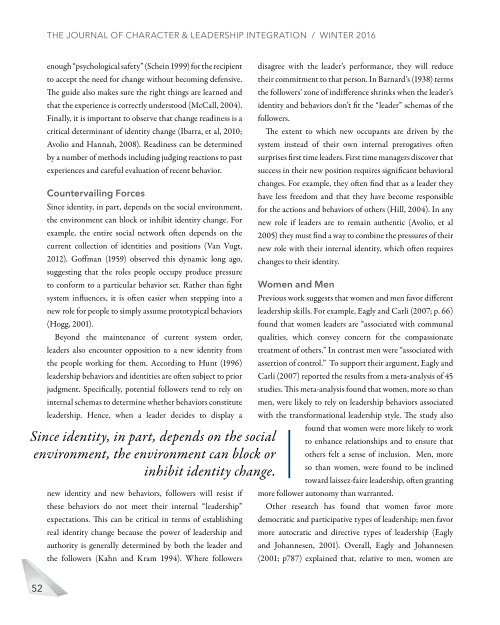PROFESSION OF ARMS
Yi5mwL
Yi5mwL
You also want an ePaper? Increase the reach of your titles
YUMPU automatically turns print PDFs into web optimized ePapers that Google loves.
THE JOURNAL <strong>OF</strong> CHARACTER & LEADERSHIP INTEGRATION / WINTER 2016<br />
enough “psychological safety” (Schein 1999) for the recipient<br />
to accept the need for change without becoming defensive.<br />
The guide also makes sure the right things are learned and<br />
that the experience is correctly understood (McCall, 2004).<br />
Finally, it is important to observe that change readiness is a<br />
critical determinant of identity change (Ibarra, et al, 2010;<br />
Avolio and Hannah, 2008). Readiness can be determined<br />
by a number of methods including judging reactions to past<br />
experiences and careful evaluation of recent behavior.<br />
Countervailing Forces<br />
Since identity, in part, depends on the social environment,<br />
the environment can block or inhibit identity change. For<br />
example, the entire social network often depends on the<br />
current collection of identities and positions (Van Vugt,<br />
2012). Goffman (1959) observed this dynamic long ago,<br />
suggesting that the roles people occupy produce pressure<br />
to conform to a particular behavior set. Rather than fight<br />
system influences, it is often easier when stepping into a<br />
new role for people to simply assume prototypical behaviors<br />
(Hogg, 2001).<br />
Beyond the maintenance of current system order,<br />
leaders also encounter opposition to a new identity from<br />
the people working for them. According to Hunt (1996)<br />
leadership behaviors and identities are often subject to prior<br />
judgment. Specifically, potential followers tend to rely on<br />
internal schemas to determine whether behaviors constitute<br />
leadership. Hence, when a leader decides to display a<br />
Since identity, in part, depends on the social<br />
environment, the environment can block or<br />
inhibit identity change.<br />
new identity and new behaviors, followers will resist if<br />
these behaviors do not meet their internal “leadership”<br />
expectations. This can be critical in terms of establishing<br />
real identity change because the power of leadership and<br />
authority is generally determined by both the leader and<br />
the followers (Kahn and Kram 1994). Where followers<br />
disagree with the leader’s performance, they will reduce<br />
their commitment to that person. In Barnard’s (1938) terms<br />
the followers’ zone of indifference shrinks when the leader’s<br />
identity and behaviors don’t fit the “leader” schemas of the<br />
followers.<br />
The extent to which new occupants are driven by the<br />
system instead of their own internal prerogatives often<br />
surprises first time leaders. First time managers discover that<br />
success in their new position requires significant behavioral<br />
changes. For example, they often find that as a leader they<br />
have less freedom and that they have become responsible<br />
for the actions and behaviors of others (Hill, 2004). In any<br />
new role if leaders are to remain authentic (Avolio, et al<br />
2005) they must find a way to combine the pressures of their<br />
new role with their internal identity, which often requires<br />
changes to their identity.<br />
Women and Men<br />
Previous work suggests that women and men favor different<br />
leadership skills. For example, Eagly and Carli (2007; p. 66)<br />
found that women leaders are “associated with communal<br />
qualities, which convey concern for the compassionate<br />
treatment of others.” In contrast men were “associated with<br />
assertion of control.” To support their argument, Eagly and<br />
Carli (2007) reported the results from a meta-analysis of 45<br />
studies. This meta-analysis found that women, more so than<br />
men, were likely to rely on leadership behaviors associated<br />
with the transformational leadership style. The study also<br />
found that women were more likely to work<br />
to enhance relationships and to ensure that<br />
others felt a sense of inclusion. Men, more<br />
so than women, were found to be inclined<br />
toward laissez-faire leadership, often granting<br />
more follower autonomy than warranted.<br />
Other research has found that women favor more<br />
democratic and participative types of leadership; men favor<br />
more autocratic and directive types of leadership (Eagly<br />
and Johannesen, 2001). Overall, Eagly and Johannesen<br />
(2001; p787) explained that, relative to men, women are<br />
52


